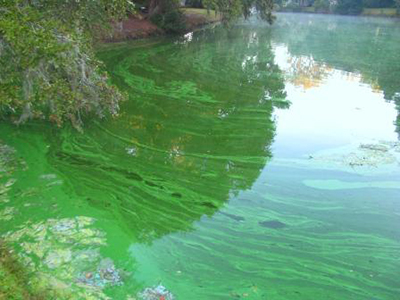Planktonic algae are microscopic plants that live in every drop of pond water. These primitive creatures are extremely important to the aquatic ecosystem because they are the base for the food chain and are largely responsible for the chemistry of the pond. Planktonic algae are important because they produce oxygen and food for the animals that live in the pond. These tiny plants get their nutrients directly from the water, so their growth and reproduction are dependent on the amount of nutrients (i.e. fertilizer) in the water. Because stormwater ponds collect water flowing from yards and roads in the community, they often grow an abundance of algae as a result of the many sources of nutrients in residential and commercial developments.
-
Is murky green water unhealthy? Should the water be clear?
No, not necessarily. The murkiness is a sign of a growing plankton population which is responding to nutrients that have washed into the pond. This is Nature's way of capturing nutrients that might otherwise contaminate rivers and beaches. The image on the right shows a healthy pond where green algae are managing nutrients in the water.
-
Can too much algae become a problem?
Yes. A severe algal bloom can cause a fish kill because the death and decay of the algae will remove oxygen from the water.
-
How do I know that I have too much planktonic algae?
Use a secchi disk or a white object that will sink and tie it to a string. Mark the string at 18 inches above the object, and lower the object into the pond. If the object is still visible at 18 inches below the surface, the pond does not have too much algae. If the object disappears before 18 inches below the surface, you likely have an algae bloom that is increasing the risk of a fish kill due to low oxygen.
-
Are there any particularly bad algae?
Yes. One group of algae, known as blue-green algae (cyanobacteria), can produce toxins that can affect the health of fish and animals that come into contact with the water. Cyanobacteria often become problems when the pond receives too much phosphorous, a condition that is most often associated with runoff that contains excessive lawn fertilizers or animal wastes. Cyanobacteria are normally very bright green and usually form a film on the surface. Most other planktonic algae are darker green and do not form surface films. There are some cyanobacteria that do not form surface films and a few that are filamentous. On occasion a pond may develop "red algae," which also may be harmful to aquatic animals. "Red algae" are not actually algae, but their growth and control are similar to that of other planktonic algae.

Cyanobacteria bloom

Red algae bloom (euglena sanguinea)
-
How do I control planktonic algae blooms?
The only ways homeowners can prevent recurring algae blooms are 1) to reduce the nutrients washing into the pond and 2) to use other plants or compounds to absorb nutrients from the water. Licensed applicators can treat algae blooms using properly labeled herbicides, but, unless the nutrients are reduced, the chemical herbicides will provide only temporary control of algae blooms. Also, ponds that are experiencing an algal bloom are more likely to have a fish kill when treated with an herbicide because of the rapid death and decay of the algae, so it is important to provide adequate circulation when ponds develop severe algal blooms (see Circulation/Aeration).
-
Can homeowners or HOA officers apply aquatic herbicides to stormwater ponds?
No. In most cases stormwater ponds are considered to be community property because multiple property owners abut the pond. The water moves freely from one property to the next and usually the HOA, a delegated community entity, has a maintenance easement. Anyone applying herbicides to the water is liable for damages that may occur from that application. Only pesticide applicators licensed in category 5 (aquatic herbicides) should apply labeled herbicides to stormwater ponds.
-
How can homeowners or HOAs prevent and control algae blooms?
- Soil test before fertilizing your lawn to prevent over-fertilizing.
- Sweep/blow fertilizers and grass clippings off of roads and driveways to prevent them from washing into storm drains.
- Do not apply fertilizers on the bank slopes of ponds.
- Do not discard grass clippings or yard waste in ponds, ditches, or street drains.
- Pick up pet waste.
- Do not wash cars in driveways - the soaps break down into nutrients that grow algae. Wash cars on the lawn instead and use phosphorus-free soaps.
- Do not feed fish, turtles, or waterfowl. These animals turn food into fertilizer and are healthier when they feed themselves naturally.
- Plant wetland plants along the shoreline to filter runoff and absorb nutrients.
- Place floating wetlands in the pond to extract nutrients directly from the water.
- Consider circulation systems that increase oxygen conditions in the pond.


